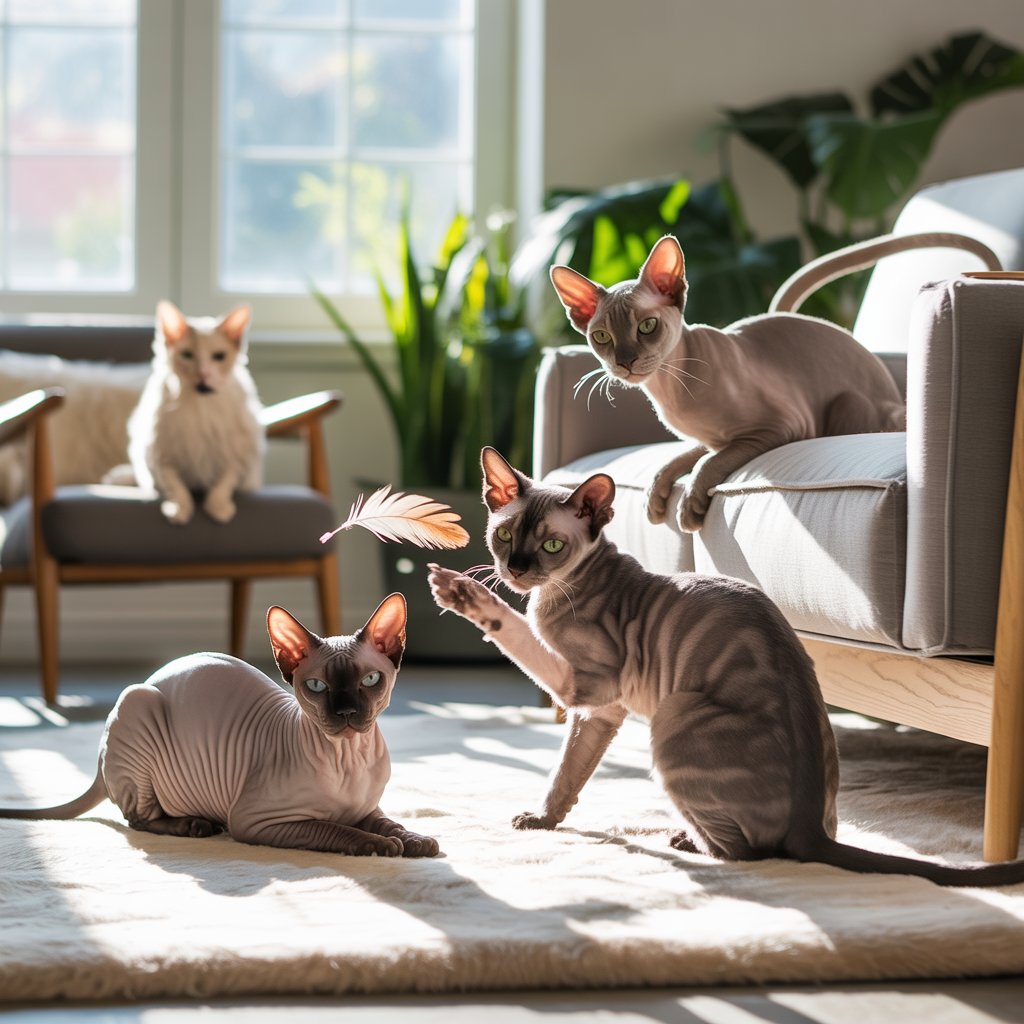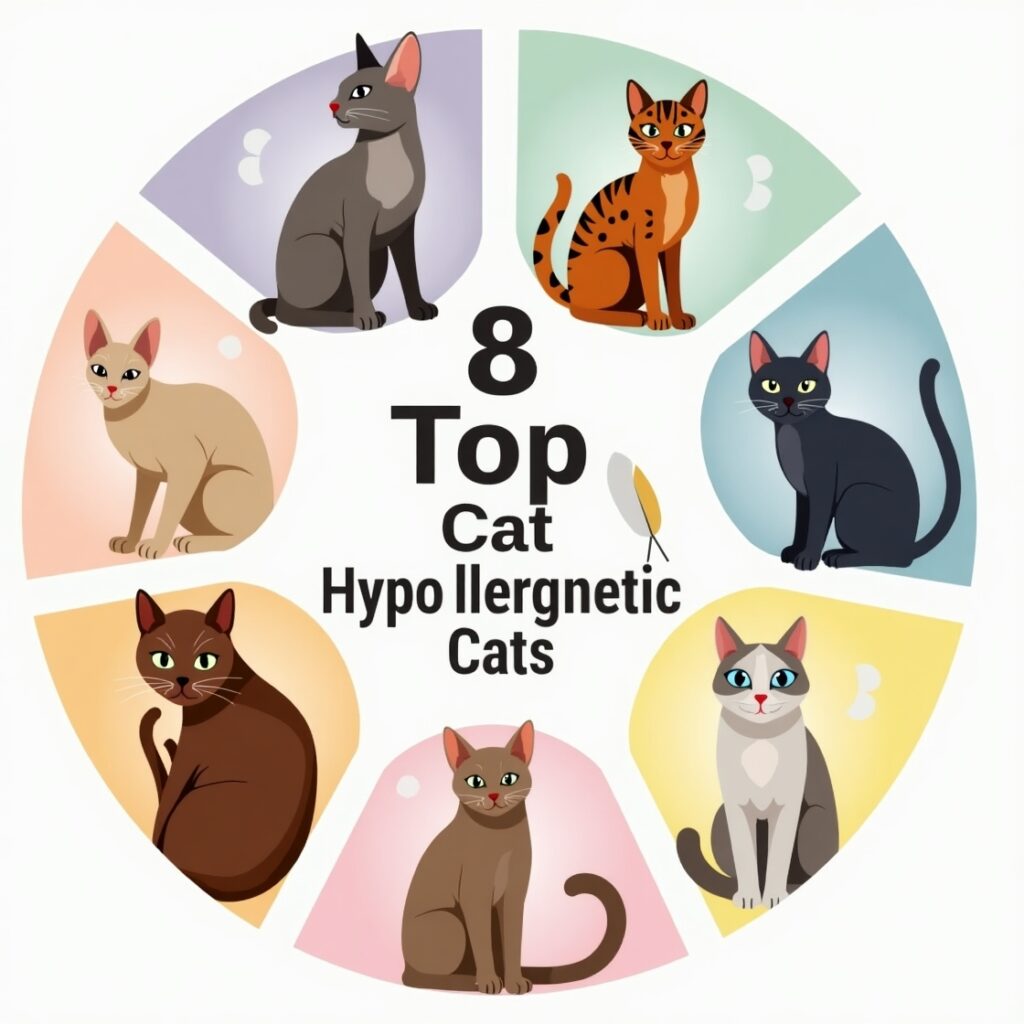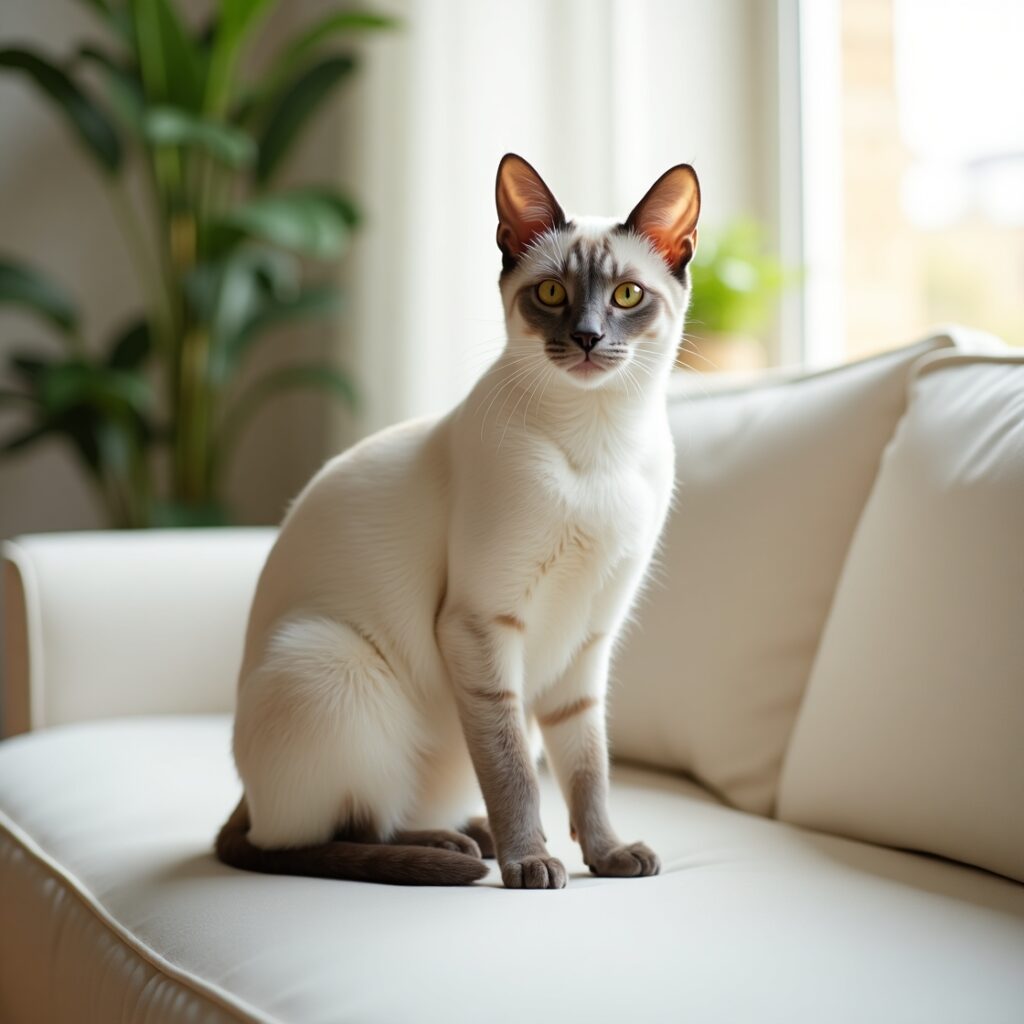Table of Contents
Table of Contents
Have you always desired a cat but are deathly allergic to them?
It’s estimated that one in every ten people in America is allergic to cats. Cat saliva contains a protein called Fel D1, which is a stimulating factor for a lot of allergic responses.
Cats tend to lick and slobber on their fur, and when this happens, the saliva hardens.
and forms the allergen that causes allergic reactions. While no cat is fully allergen-free, hypoallergenic cats are cats that naturally release fewer
allergens.
LaPerm Cat
The LaPerm is a friendly breed that was produced in the 1980s in the US to help with pest management. It has a thick, wavy coat and a messy haircut.
This coat is neither velvety nor silky as compared to other breeds, but it does create
friction when sliding your fingers through it.
The coat of the LaPerm is said to be mostly hypoallergenic for cats.
LaPerm hypoallergenic cats also weigh between 8 and 15 pounds and can live from 14 to 15 years.
Sphynx Cat
Originating from Toronto, Canada, the distinct almond-shaped eyes, big pointy ears, and bald
The look of the Sphynx cat makes it a very unique cat.
In the 1960s, this breed was made from selective breeding to produce a somewhat hairless cat.
The Sphynx is not fully hairless, and its lack of hair, as compared to other cats, makes
It is one of the most hypoallergenic cat breeds.

The Sphynx is a sociable, hypoallergenic cats with a cheerful personality that has been likened to that
of dogs.
It is also known for being receptive to strangers, and they are lively and very athletic.
Sphynx hypoallergenic cats do not have a coat for shedding or grooming, meaning they are more sensitive
to chilly weather.
A healthy Sphynx hypoallergenic cats normally weighs between 8 and 11 pounds and can survive for, 15 to 20
years.
Bengal Cat
The Bengal cat is not known to be a cuddly cat, but it is loving and likes the companionship of humans, particularly youngsters. They are quite active and like playing sports and hunting, something they inherited from their wild predecessors. The Bengal is recognized for its smooth, silky coat, which comes in just two coat pattern variations: spotted and marbled.
The spotted pattern is the most prevalent pattern, and both patterns are frequently tricolored—giving every Bengal cat its distinctive markings and patterning. Some Bengals have markings with a darker edge, mimicking the markings of a jaguar.
The Bengal’s fur contains less allergen-rich saliva, and they shed significantly less. Male Bengals cats can weigh from 8 to 15 pounds, while female Bengals between 8 and 13 pounds.
Russian Blue Cat
The Russian Blue breed is perfect for families since it is accommodating of youngsters, although
They tend to have a favorite family member with whom they like to spend time.
The Russian Blue is distinguished by its stunning bluish-gray coat.
Compared to other breeds, the Russian Blue sheds very little and emits very little of
the protein Fel D1 and is very suitable for people with allergies.
Their eyes have a rich emerald color that is unique to the Russian Blue breed.
Russian Blue hypoallergenic cats weight is between 6 and 15 pounds on average, with the males being bigger
than the females.
They can live from 15 to 18 years.
Oriental Shorthair Cat
The Oriental Shorthair has beautiful eyes shaped like almonds, with long and pointy
ears.
They have a wedge-shaped head and a long, slim figure.
Oriental Shorthairs have a short, smooth coat that barely sheds; thus, people with hypoallergenic cats
have little to no reaction to them.
These cat breeds are extremely clever.
They remain active and inquisitive well even as they mature and require a lot of socialization.
They enjoy the presence of other feline breeds, but human exposure is very vital to them.
The Oriental Shorthair can weigh from 6 to 15 pounds and will live from 15 to 20 years.
Burmese Cat
Burmese cats are not hypoallergenic cats but are often recommended for allergy sufferers due to their low shedding. They produce the primary allergen, Fel D1 protein, found in saliva, skin, and urine, making it unlikely that a Burmese cat won’t trigger an allergic reaction. Burmese cats are bright and enjoy playing, and they do not like being left alone at home.
especially if there are no activities or toys to keep them entertained.
Burmese cats have shorter, glossy coats, and although they do not shed as little as the
other cats that have been mentioned, they are still in the lower range of cats that
shed.
Burmese cats may weigh between 6 and 12 pounds and have a lifespan of 13 to 16 years.
Ocicat
Ocicats are a popular choice for hypoallergenic cats sufferers due to their low-shedding nature and reduced protein production, making them less likely to trigger allergies compared to other breeds, although no cat is truly hypoallergenic cats. The Ocicat is a muscular, energetic, and remarkably intellectual breed that looks similar to a small Ocelot.
These cats are sociable and conversational and like to interact and engage with their owners.
The markings on their coats are very distinctive.
They can be seen on the flanks of the torso, shoulders, and hind legs, and they are well
dispersed in a distinctive pattern.
Some Ocicats, as opposed to the hydrophobic nature of cats, like water and enjoy swimming.
These cats thrive in the presence of other cats or dogs.
The female Ocicats can weigh up to six to eight pounds, and the males eight to fourteen pounds.
They can live as long as twelve to fourteen years.
Devon Rex
The Devon Rex is recognized for its lustrous and wavy fur, huge ears, and a pronounced
jawline.
Their tall ears and slender bodies resemble that of an elf.
The breed was created in England during the 1960s when a kitten from a litter had a natural
mutation that gave it elf-like features and curly hair.

Because of its short, curly coat, it doesn’t shed much, limiting the transmission of allergens
in the house.
The Devon Rex is a smallish cat, and males can weigh between 6 and 8 pounds and females
weigh between 4 and 6 pounds.
They can live for 9 to 13 years.
Siberian Cat
The Siberian cat is a huge, sturdy cat with a unique temperament that is similar to that
of a dog.
Siberian cats, often referred to as “hypoallergenic cats,” are known for their lower levels of Fel d 1 protein, a common allergen in cats. Although not completely hypoallergenic cats, Siberians are a suitable option for mild allergy sufferers.
It always wants to seek the attention of its owners and will follow them from place to
place. The Siberian Cat has a luscious triple coat consisting of a velvety undercoat, an outer
coat, and a topcoat with lustrous, waterproof hairs.
They lose their thick coat as the seasons change, and frequent brushing can help maintain
their coat and prevent it from tangling.
This eye-catching coat alters with time, and the colors dim as the cat gets older.
Although the Siberian Cat has longer fur, they have lower levels of allergy-causing
substances in their saliva, making them hypoallergenic cats.
Javanese Cat
The Javanese cat is a smart, talkative, and lively feline. Javanese cats are hypoallergenic cats due to their low shedding and minimal dander production, producing fewer allergens like Fel d 1 protein. Although not allergen-free, they are suitable for mild to moderate hypoallergenic cats sufferers.
They demand quite a high level of interpersonal interactions since they like playing and exploring.
The Javanese was developed in the US in the s, despite it having no relation to the
Java Island is located in Indonesia.
This breed has a long, lustrous coat that can come in a variety of appealing colors
and sometimes may have colorpoint patterns.
Although the Javanese Cat has long fur, it is mostly hypoallergenic thanks to their low
shedding level and inability to produce high amounts of allergen-causing proteins.
The Javanese can weigh anything between six and twelve pounds and can live up to nine to fifteen years.
Cornish Rex Cat
The Cornish Rex, which originated in Cornwall, England, is known as the Greyhound of cats
due to their elegant and long physique and the way this breed runs. Cornish Rex cats, despite their unique, curly coat and reduced shed, still produce the allergen Fel d 1, primarily found in their saliva, dander, and urine. Most cat breeds have three different types of hair in their fur, the ‘guard hairs,’
‘awn hairs’ and ‘down hairs.’
However, the Cornish Rex only has ‘down hairs,’ which are only one centimeter long.
Because of its short, downy coat, the Cornish Rex is an ideal hypoallergenic breed.
Their coat is incredibly thin and can be frizzy at times and comes in a variety of colors.
Cornish Rex males can weigh from 6 to 12 pounds, while females can weigh from 4 to
7 pounds.
Balinese Cat
The Balinese cat is a laid-back, sociable feline. Balinese cats are often considered hypoallergenic cats, making them a suitable choice for those with allergies due to their lower production of the main allergen protein, Fel d 1, and their reduced shedding, further reducing allergen exposure.
They are recognized for their distinct fur coloration and piercing blue eyes.

Similar to the Javanese cat, Balinese cats have no relation to Bali Island in Indonesia.
They prefer being among other people and dislike being left by themselves for extended periods.
They will frequently accompany you about the house, curious about whatever you are doing.
Balinese Cats can be compared to the Siamese cats, although they are not as high-strung
and certainly not as noisy.
Balinese cats are believed to have a lower concentration of the Fel d1 protein, making
them ideal for people with allergies.
Balinese Cats have a more delicate and lengthy hair, reaching roughly two to five cm.
Balinese cats can weigh up to five to eleven pounds and live up to an average of twelve years.
FAQs About hypoallergenic cats
1. So, are hypoallergenic cats totally safe for folks with allergies?
Not really. I mean, no cat is completely allergen-free. But yeah, some breeds just make less of the stuff that causes reactions.
2. What is it exactly that makes people allergic to cats?
It’s something in their spit — FelD is what it’s called. Cats clean themselves, then that dries on their fur, and boom — that’s what gets people.
3. Can someone still react to a so-called hypoallergenic cats?
Yep. Sadly, even these types might still trigger allergies — just not as bad. It’s more like, the reaction is reduced, not gone.
4. Is there a way to be sure before getting one?
Yeah, you should spend time with a cat from the same breed. You’ll kinda know if your body’s okay with them or not.
5. Which breeds are like, the easiest to live with if you’re allergic?
Well, Bengals are cool — they don’t shed much and their fur has less saliva stuff. Oriental Shorthairs also hardly shed, which helps.
Related Articles from EffortWiz.com
If you found this article helpful, you might also enjoy reading:
🐶 Hypoallergenic Dogs – The Best Breeds for Allergy Sufferers
Discover which dog breeds are considered hypoallergenic and why they might be a great fit for allergy-prone families.
🏥 Nationwide Pet Insurance – Is It Worth It?
A detailed breakdown of Nationwide’s pet insurance plans, what they cover, and whether they’re a smart choice for your pet’s health needs.
🍽️ Homemade Dog Food – Healthy Recipes You Can Trust
Learn how to prepare nutritious, balanced meals at home for your dog using veterinarian-approved recipes.
🐾 The Science Behind Puppy Dog Eyes
Explore the fascinating psychology and biology behind those irresistible puppy eyes and what they really mean.
🐱 Why Is My Cat Not Eating? 10 Reasons You Should Know
Understand the common reasons behind appetite loss in cats and what you should do if your feline refuses to eat.
